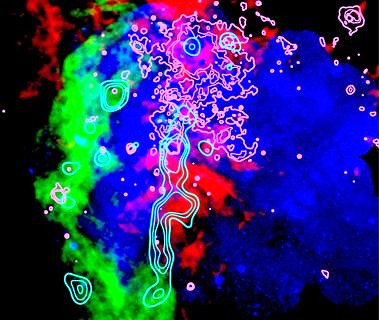FAU research team investigate new star-forming region

When clouds collide
A triangular structure in the largest satellite galaxy surrounding the Milky Way has left astrophysicists around the world puzzled due to its unusually energetic X-ray emissions. FAU researchers have now investigated this phenomenon using the ESA XMM-Newton X-ray observatory and can reveal that it is caused by the collision of two gas clouds, which will most likely cause a new star-forming region.
The Large Magellanic Cloud (LMC) is the largest of the satellite galaxies surrounding the Milky Way and is host to many fascinating celestial objects. The brightest and most interesting structure in the LMC is the emission nebula 30 Doradus, also known as the Tarantula nebula, which is one of the most active star-forming regions. Emission nebulae are formed from clouds of interstellar gas that emit light in different colours.
X-ray observations have revealed an intriguingly large, triangular structure just south of 30 Doradus, called the ‘X-ray spur’ which has left astrophysicists puzzled as its X-ray emissions appear to be more energetic than usually expected from similar structures.
Higher temperature than expected
Researchers at the Dr. Karl Remeis Observatory at FAU have now studied the X-ray spur using ESA’s XMM-Newton X-ray observatory in an international collaboration. ‘The high-energy radiation of the structure was first discovered in the 1990s with the German ROSAT X-ray telescope and has been a puzzle ever since. Thanks to XMM-Newton, we are now able to study interstellar structures of this size for the first time,’ explains FAU astrophysicist Prof. Dr. Manami Sasaki.
The study shows that the plasma in the X-ray spur indeed has a higher temperature than typically expected for the LMC. In fact, it is comparable to the temperature in the emission nebula 30 Doradus, which has been heated by a large number of young, massive stars.
A new star-forming region is likely
‘Our multiwavelength analysis shows that there are no indications for the past and present existence of massive stars, which might have explained the heating of the plasma in the X-ray spur,’ explains Jonathan Knies, who led the study.
‘Instead, the X-ray spur is located between two giant clouds of atomic hydrogen, which are in the process of colliding with each other and seem to cause the heating of the environment. This collision most likely started further north, at around the position where 30 Doradus is located now and is continuing to the south. We expect that the X-ray spur will eventually evolve into an active star-forming region like 30 Doradus and its surroundings.’
The study which connects the origin of the X-ray spur with that of 30 Doradus for the first time was recently published in the journal Astronomy & Astrophysics.
The image in the ESA press release (see above) shows the complex structure of the interstellar gas and clouds in the LMC, with the XMM-Newton data being the last piece that was missing in the puzzle.
In the image, the two colliding atomic hydrogen components (cold gas) are shown in green and red, while the X-ray emission observed with XMM-Newton (hot plasma) is shown in blue. The image also shows H-alpha emission from the gas which was ionised by the massive stars, shown as magenta contours and the emission from molecular clouds (high-density regions harbouring new star-forming regions) shown as cyan contours.
Further information
DOI: 10.1051/0004-6361/202038488
Dr. Karl Remeis Observatory, Friedrich-Alexander-Universität Erlangen-Nürnberg
Jonathan Knies
E-mail: jonathan.knies@fau.de
Prof. Dr. Manami Sasaki
E-mail: manami.sasaki@fau.de